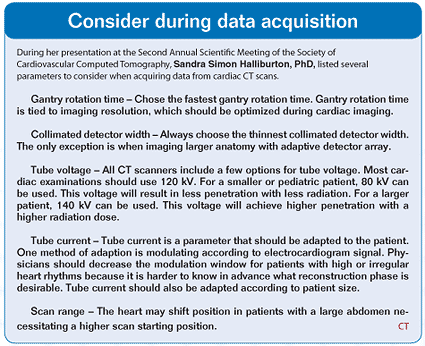Learn tips and tricks for optimal CT image quality
There are certain techniques that can help optimize computed tomography image quality.
 These
techniques include methods for patient preparation, contrast administration,
data acquisition and data reconstruction, according to Sandra Simon
Halliburton, PhD, a cardiovascular imaging scientist at the Cleveland
Clinic and a professor in the department of chemical and biomedical engineering
at Cleveland State University.
These
techniques include methods for patient preparation, contrast administration,
data acquisition and data reconstruction, according to Sandra Simon
Halliburton, PhD, a cardiovascular imaging scientist at the Cleveland
Clinic and a professor in the department of chemical and biomedical engineering
at Cleveland State University.
Halliburton presented a brief overview of techniques that can help improve imaging results at the Second Annual Scientific Meeting of the Society of Cardiovascular Computed Tomography.
Patient preparation
Patient preparation is one of the most important steps that can be taken to optimize image quality, Halliburton said. First, screen the patient to make sure that IV access can be obtained in the cubital vein, specifically that an 18 gauge catheter or larger can be placed to access coronaries.
Physicians know that high or irregular heart rates can affect CT scans. “For patients in whom heart rate is an issue you will need to consider heart rhythm lowering drugs,” Halliburton said. “In those patients, physicians should screen for any contraindications to beta-blockers or calcium antagonists.”
Patient size is also an issue when using cardiac CT.
|
|
Furthermore, patients should be screened for the likelihood of significant coronary calcium. This step is important in patients with positive prior coronary calcium, patients with diabetes and known renal disease and patients of an advanced age, particularly men aged 70 or older.
Finally, patient instructions can significantly impact image quality. If scheduled for a noncontrast enhanced scan, advise the patient to avoid caffeine to keep the heart rate down during the scan. If scheduled for a contrast-enhanced scan, advise the patient to fast for at least four hours prior to the scan.
After the patient arrives, instruct them to lie motionless, warn them of side effects from contrast, and practice the breath hold.
Contrast administration
Contrast administration is the next step before the start of the scan. There are two prevailing methods used to determine the delay between contrast injection and the start of the scan: bolus monitoring and timing bolus.
Bolus monitoring uses a single injection contrast agent, is often considered to be faster and uses a smaller total contrast volume compared with timing bolus.
When using the timing bolus method, a small amount of contrast agent is used to determine the time to peak in the region of interest. This technique may outweigh the bolus monitoring technique for specific patients: those with low cardiac output, patients who are obese and may not reach attenuation threshold or patients with difficulty breathing.
Halliburton also recommended using saline or saline/contrast mix following contrast administration to help reduce right heart artifacts.

Data acquisition
As data acquisition begins the first decision made is whether to use the axial/sequential or helical/spiral mode, Halliburton said.
“You only want to use the axial/sequential mode if patients have a low, stable heart rate, because you only have one opportunity to acquire data during one cardiac phase,” she said. “However, the big advantage in this mode is the decreased radiation dose.”
Helical/spiral mode is a better choice if the patient has an irregular heart rate. With this mode there is low sensitivity to arrhythmia, physicians can image during multiple cardiac phases and can use functional imaging. However, the disadvantage is an increased radiation dose.
In addition to the acquisition mode, physicians should also consider gantry rotation time, the collimated detector width, tube voltage, tube current and the scan range.
Data reconstruction
During data reconstruction it is important to consider the adjustment of reconstruction thickness. For evaluation of small anatomic detail, such as coronaries, reconstruction thickness is slightly wider than detector, 0.6 mm to 0.75 mm. For evaluation of larger anatomic detail, such as the pulmonary vein or pericardium, reconstruction thickness is typically 1.5 mm to 2 mm.
Remember that reconstruction phase is a function of many things: gantry rotation time, number of reconstruction segments, pitch, patient’s heart rate and more, Halliburton said.
Finally, it is important to use the right filter or kernel during data reconstruction. Dedicated reconstruction filters or kernels should be used for cardiac imaging, but physicians should choose a “sharper” filter or kernel for stents, she said. – by Leah Lawrence
For more information:
- Halliburton SS. Tips and tricks to optimize image quality. Presented at: the Second Annual Scientific Meeting of the Society of Cardiovascular Computed Tomography; July 5-8, 2007; Washington.

